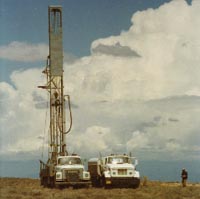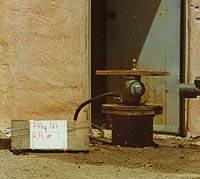

THERMONICS
Scientists at American Ground Water Consultants (AGW) developed Thermonics, a new geophysical technique, that enabled them to locate high capacity wells for a Horizon Corporation in the Tucson Basin of Arizona.
|
|
We have developed proprietary methods for removing transient temperature effects near the surface caused by wind and solar radiation and variable thermal properties of the soil. This enables us to locate the best well sites.
|
|
We applied our Thermonic method, along with standard geological methods, and identified a narrow, sand-filled stream channel cut deeply into the bedrock. The channel was only 100 feet (30 meters) wide and one-half mile (1.6 km) long.
The first well drilled into our target zone produced in excess of 600 gallons per minute. Seven more wells quickly followed. The best well produced 1,000 gallons per minute (65 l/s). Flush with success, our client's engineering and well-drilling firms decided there was water everywhere in the area. The ninth well site was selected by the engineering firm. The 16-inch (41 cm) diameter well was drilled to 1,000 feet (305 m). It missed the sand-filled channel, and produced several gallons per day.
|
|
Thermonics has since been applied to a wide range of problems both in the United States and abroad. A few of our projects solved by Thermonics include:
Optimum Well-Site Location in the Tablazo Formation at the Chapucal Well Field, Ecuador, S.A.
Ground-Water Recharge and Transmissivity Distribution in the Hermosillo Basins, Sonora, Mexico
Well-Site Location Using Hydrogeologic and Thermonic Methods at Leon, Guanajuato, Mexico
Location of Paths of High Ground-Water Flow in the Foundation of Tarbela Dam, West Pakistan
Location of Paths of Ground-Water Flow into the Marampa Open-Pit Iron Mine, Lunsar, Sierra Leon, West Africa
Thermonic Location of Optimum Well Sites for Congress Junction, Arizona, U.S.A.
Ground-Water Exploration in the Pearce-Squaretop Hills Area, Cochise County, Arizona, U.S.A.
Thermonic Exploration for Optimum Well Sites on the Sahuarita Bombing Range South of Tucson, Arizona, U.S.A.
Thermonic Ground-Water Exploration and Well-Site Location Survey near Liberal, Kansas, U.S.A.
Use of Thermonics in Studies of the Karst Foundation of Wolf Creek Dam, Kentucky, U.S.A.
Well-Sites Location and Tracing of Buried River Channel Sands in the Jurassic Morrison Formation, McKinley County, New Mexico, U.S.A.
Well-Site Location in the North Boundary Channel of the Ca?ada de Los Alamos Land Grant, Santa Fe, New Mexico, U.S.A.
Thermonic Optimum Well-Site Location and Evaluation of the Ground-Water Flow System near Regina, New Mexico
Comparison of Conventional and Thermonic Methods for Evaluating Ground-Water Budgets - Santa Fe County, New Mexico, U.S.A..
? 1999-2016 AGW Consultants. All Rights Reserved.


